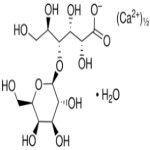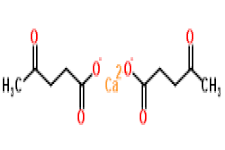Calcium Lactobionate USP FCC Food Grade & Calcium Levulinate USP BP Ph Eur Grade Suppliers Exporters, Manufacturers
Calcium Lactobionate
CAS Number: USP FCC Food Grade 110638-68-1, Suppliers Exporters, Manufacturers
Please visit Safety Data Sheet of Calcium Lactobionate Manufacturers.
Specifications of Calcium Lactobionate USP Grade
C24H42CaO24.2H2O -- 790.68
D-Gluconic acid, 4-O- -D-galactopyranosyl-, calcium salt (2:1), dihydrate.
Lactobionic acid, calcium salt (2:1), dihydrate.
Calcium lactobionate (1:2), dihydrate CAS 110638-68-1
Calcium Lactobionate contains not less than 96.0 percent and not more than 102.0 percent of C24H42CaO24.2H2O.
Identification:
A: A solution (1 in 50) responds to the tests for Calcium.
B: Infrared Absorption 197K.
C: Dissolve a quantity of it in water to obtain a test solution containing 10 mg per mL. Similarly prepare a Standard solution of USP Calcium Lactobionate RS in water containing 10 mg per mL. Apply separately 5 :L of the test solution and 5 :L of the Standard solution to a suitable thin-layer chromatographic plate coated with a 0.25-mm layer of chromatographic silica gel. Dry the plate in a current of cool air. Place the plate in a suitable chromatographic chamber lined with filter paper and previously equilibrated with a solvent system consisting of a mixture of alcohol, water, ethyl acetate, and ammonium hydroxide (50:30:10:10). Develop the chromatogram until the solvent front has moved about three-fourths of the length of the plate. Remove the plate from the chamber, and dry at 100 for 20 minutes. Allow to cool, and spray with a spray reagent prepared as follows. Dissolve 2.5 g of ammonium molybdate in about 50 mL of 2 N sulfuric acid in a 100-mL volumetric flask, add 1.0 g of ceric sulfate, swirl to dissolve, dilute with 2 N sulfuric acid to volume, and mix. Heat the plate at 110 for about 10 minutes: the principal spot obtained from the test solution corresponds in color, size, and RF value to that obtained from the Standard solution.
Specific rotation: between +22.0 and +26.5 .
pH: between 5.4 and 7.4, in a solution (1 in 20).
Halides: A 1.2-g portion tested as directed under Chloride shows no more turbidity than corresponds to 0.7 mL of 0.020 N hydrochloric acid (0.04%).
Sulfate: A 2.0-g portion dissolved in boiling water shows no more sulfate than corresponds to 1 mL of 0.020 N sulfuric acid (0.05%).
Heavy metals: Mix 1 g with 4 mL of 1.2 N hydrochloric acid, add water to make 25 mL, warm gently until dissolved, and cool to room temperature: the limit is 0.002%.
Reducing substances: Transfer 1.0 g to a 250-mL conical flask, dissolve in 20 mL of water, and add 25 mL of alkaline cupric citrate. Cover the flask, boil gently for 5 minutes, accurately timed, and cool rapidly to room temperature. Add 25 mL of 0.6 N acetic acid, 10.0 mL of 0.1 N iodine, and 10 mL of 3 N hydrochloric acid, and titrate with 0.1 N sodium thiosulfate, adding 3 mL of starch as the endpoint is approached. Perform a blank determination, omitting the specimen, and note the difference in volumes required. Each mL of the difference in volume of 0.1 N sodium thiosulfate consumed is equivalent to 2.7 mg of reducing substances (as dextrose): the limit is 1.0%.
Specifications of Calcium Lactobionate FCC Food Grade
Calcium 4-(_,D-Galactosido)-D-gluconate
C24H42CaO24 Formula weight, anhydrous 754.66
CAS 5001-51-4
DESCRIPTION
Calcium Lactobionate occurs as a white to cream-colored, free-flowing powder. It readily forms double salts, such as the chloride, bromide, and gluconate. It is anhydrous when obtained by spray-drying, or the dihydrate when obtained by crystallization. It is freely soluble in water, but insoluble in alcohol and in ether. It decomposes at about 120C. The pH of a 1:10 aqueous solution is between 6.5 and 7.5.
Function: Firming agent in dry pudding mixes; nutrient.
REQUIREMENTS
Labeling: Indicate whether the product has been obtained through spray-drying or from crystallization.
Identification
A. The infrared absorption spectrum of a potassium bromide dispersion of the sample, previously dried at 105C for 8 h, exhibits relative maxima at the same wavelengths as those of a similar preparation of USP Calcium Lactobionate Reference Standard.
B. A sample gives positive tests for Calcium.
Calcium Content: Not less than 5.05% and not more than 5.55% of calcium (Ca), calculated on the dried basis.
Halides: Not more than 0.04%.
Lead: Not more than 2 mg/kg.
Loss on Drying: Not more than 8.0%.
Optical (Specific) Rotation [α]D20C: Between +23° and +25°.
Reducing Substances: Not more than 1.0%.
Sulfate: Not more than 0.7%.

Please visit Hazard Statement of Calcium Lactobionate USP FCC Food Grade Manufacturers.
Calcium Levulinate
CAS Number: 5743-49-7 for Dihydrate and 591-64-0 for Anhydrous, USP BP Ph Eur Grade Suppliers Exporters, Manufacturers
Please visit Safety Data Sheet of Calcium Levulinate Manufacturers.
Specifications of Calcium Levulinate USP Grade
C10H14CaO6.2H2O -- 306.32
Pentanoic acid, 4-oxo-, calcium salt (2:1), dihydrate.
Calcium levulinate (1:2) dihydrate [5743-49-7].
Anhydrous 270.30 [591-64-0].
Calcium Levulinate contains not less than 97.5 percent and not more than 100.5 percent of C10H14CaO6, calculated on the dried basis.
Identification:
A: A solution (1 in 10) responds to the tests for Calcium.
B: To a solution of 0.5 g in 5 mL of water add 5 mL of 1 N sodium hydroxide, and filter. To the filtrate add 5 mL of iodine: a precipitate of iodoform is produced.
Melting range: between 119 and 125 .
pH: between 7.0 and 8.5, in a solution (1 in 10).
Loss on drying: Dry it at a pressure not exceeding 5 mm of mercury at 60 for 5 hours: it loses between 10.5% and 12.0% of its weight.
Chloride: A 1.0-g portion shows no more chloride than corresponds to 1.0 mL of 0.020 N hydrochloric acid (0.07%).
Sulfate: A 2.0-g portion shows no more sulfate than corresponds to 1.0 mL of 0.020 N sulfuric acid (0.05%).
Heavy metals: 0.002%.
Reducing sugars: Dissolve 0.50 g in 10 mL of water, add 2 mL of 3 N hydrochloric acid, boil for about 2 minutes, and cool. Add 5 mL of sodium carbonate, allow to stand for 5 minutes, dilute with water to 20 mL, and filter. Add 5 mL of the clear filtrate to about 2 mL of alkaline cupric tartrate, and boil for 1 minute: no red precipitate is formed immediately.
Calcium Levulinate Dihydrate BP Grade
Ph Eur
C10H14CaO6,2H2O -- 306.3 -- CAS 5743-49-7
Action and use: Source of calcium.
DEFINITION
Calcium di(4-oxopentanoate) dihydrate.
Content: 98.0 per cent to 101.0 per cent (dried substance).
CHARACTERS
Appearance: White or almost white, crystalline powder.
Solubility: Freely soluble in water, very slightly soluble in ethanol (96 per cent), practically insoluble in methylene chloride.
IDENTIFICATION
First identification A, D, E.
Second identification B, C, D, E.
A. Infrared absorption spectrophotometry comparison calcium levulinate dihydrate CRS.
B. Thin-layer chromatography.
Test solution: Dissolve 60 mg of the substance to be examined in water and dilute to 1 ml with the same solvent.
Reference solution: Dissolve 60 mg of calcium levulinate dihydrate CRS in water and dilute to 1 ml with the same solvent.
Plate: TLC silica gel plate.
Mobile phase: concentrated ammonia, ethyl acetate, water, ethanol (96 per cent) (10:10:30:50 V/V/V/V).
Application: 10 μl.
Development: Over a path of 10 cm.
Drying: At 100-105C for 20 min and allow to cool.
Detection: Spray with a 30 g/l solution of potassium permanganate. Dry in a current of warm air for about 5 min or until the spots become yellow. Examine in daylight.
Results: The principal spot in the chromatogram obtained with the test solution is similar in position, colour and size to the principal spot in the chromatogram obtained with the reference solution.
C. To 1 ml of solution S (see Tests), add 20 ml of a 2.5 g/l solution of dinitrophenylhydrazine in dilute hydrochloric acid. Allow to stand for 15 min. Filter, wash the precipitate with water. Dry the precipitate in an oven at 100-105C. The melting point is 203C to 210C.
D. It gives reaction of calcium.
E. Loss on drying (see Tests).
TESTS
Solution S: Dissolve 10.0 g in carbon dioxide-free water R prepared from distilled water and dilute to 100.0 ml with the same solvent.
Appearance of solution: Solution S is clear and not more intensely coloured than reference solution.
pH: 6.8 to 7.8 for solution S.
Oxidisable substances: To 1 ml of solution S, add 10 ml of water, 1 ml of dilute sulphuric acid and 0.25 ml of a 3.0 g/l solution of potassium permanganate. Mix. After 5 min, the violet colour of the mixture is still visible.
Sucrose and reducing sugars: To 5 ml of solution S add 2 ml of hydrochloric acid and dilute to 10 ml with water. Heat to boiling for 5 min and allow to cool. Add 10 ml of sodium carbonate solution. Allow to stand for 5 min, dilute to 25 ml with water and filter. To 5 ml of the filtrate add 2 ml of cupri-tartaric solution and heat to boiling for 1 min. No red precipitate is formed.
Chlorides: Maximum 50 ppm.
Sulphates: Maximum 200 ppm.
Magnesium and alkali metals: Maximum 1.0 per cent.
To 10 ml of solution S, add 80 ml of water, 10 ml of ammonium chloride solution R and 1 ml of ammonia. Heat to boiling. To the boiling solution, add drop-wise 50 ml of warm ammonium oxalate solution. Allow to stand for 4 h, then dilute to 200 ml with water and filter. To 100 ml of the filtrate, add 0.5 ml of sulphuric acid. Evaporate to dryness on a water-bath and ignite to constant mass at 600 ± 50C. The residue weighs a maximum of 5.0 mg.
Heavy metals: Maximum 10 ppm.
Loss on drying: 11.0 per cent to 12.5 per cent, determined on 0.200 g by drying at 105C.
Pyrogens: If intended for use in the manufacture of parenteral dosage forms without a further appropriate procedure for the removal of pyrogens, it complies with the test for pyrogens. Inject per kilogram of the rabbit's mass 4 ml of a solution containing per millilitre 50 mg of the substance to be examined.

Please visit Hazard Statement of Calcium Levulinate USP BP Ph Eur Grade Manufacturers.
CAS Number 110638-68-1 Calcium Lactobionate USP FCC Food Grade & CAS Number 5743-49-7 for Dihydrate and 591-64-0 for Anhydrous Calcium Levulinate USP BP Ph Eur Grade Supplier Exporter, Manufacturer:
Annie Chemie P Ltd
Mumbai 4000010, INDIA
With Agents and offices in UAE, USA, Europe.
e-mail: info@anniechemie.com
Copyright and Usual Disclaimer is Applicable.
May 30, 2025
Exporters to USA, Canada, UK, Europe, UAE, Nigeria, Algeria, Turkey, Mexico, Brazil, Chile, Argentina, Australia, Dubai etc.
Perfection is made up of small things and that is a big thing.
